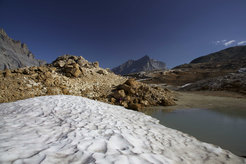Archaeologists Find Key to Tracking Ancient Wheat in Frozen Bronze Age Box
A wooden container found in an ice patch at 2,650m in the Swiss Alps could help archaeologists shed new light on the spread and exploitation of cereal grains following a chance discovery

The team, including researchers from the University of York and Dr. Jessica Hendy of the Max Planck Institute for the Science of Human History, says the technique used in the discovery of these biomarkers could be used as a new tool to help archaeologists map and trace the development of early farming in Eurasia.
The domestication of plants, such as wheat, was one of the most significant cultural and evolutionary steps of our species, but direct evidence for the use of domesticated plants, for example, in early culinary practices, has remained frustratingly elusive. Plants quickly degrade in archaeological deposits, and so archaeologists are increasingly using molecular techniques to look for their remains.
The team applied a molecular technique called gas chromatography mass spectrometry to identify lipids (fatty acids), an analysis typically used on ceramic artefacts. Over the last 30 years, thousands of ceramic artefacts from Europe have been analyzed for their molecular content, most revealing evidence of milk and meat products, but hardly any evidence of cereals.

Dr. André Colonese of the University of York, lead author of the study, states, “We didn’t find any evidence of milk, but we found these phenolic lipids, which have never been reported before in an archaeological artefact, but are abundant in the bran of wheat and rye cereals and considered biomarkers of wholegrain intake in nutritional studies.”
To support this exciting find, the team analyzed the ancient proteins found in the container. This technique also detected evidence of cereal grains and revealed that two kinds of cereals may have been kept in the box – wheat and barley or rye. A microscopic analysis confirmed the results of the molecular techniques.
Dr. Jessica Hendy, from the Max Planck Institute for the Science of Human History, says, “The evidence of cereals came from the detection of lipids, but also from preserved proteins. Combining these two kinds of molecular analysis, along with microscopic techniques, is strong evidence that cereals were being transported across this alpine pass.”
The team notes that this discovery will enable us to expand our knowledge of these important food crops and their place in the diets of ancient people, by allowing researchers to study remains that were thought to have been lost from the archaeological record.

“This is an extraordinary discovery if you consider that of all domesticated plants, wheat is the most widely grown crop in the world and the most important food grain source for humans, lying at the core of many contemporary culinary traditions. One of the greatest challenges of lipid analysis in archaeology has been finding biomarkers for plants. There are only a few and they do not preserve very well in ancient artefacts. You can imagine the relevance of this study as we have now a new tool for tracking early culinary use of cereal grains. It really is very exciting. The next step is to look for them in ceramic artefacts,” Dr. Colonese explained.
“Detecting a molecular marker for cereals also has widespread implications for studying early farming. It enables us to piece together when and where this important food crop spread through Europe,” Dr Hendy added.
Dr. Francesco Carrer from Newcastle University said: “This evidence sheds new light on life in prehistoric alpine communities, and on their relationship with the extreme high altitudes. People traveling across the alpine passes were carrying food for their journey, like current hikers do. This new research contributed to understanding which food they considered the most suitable for their trips across the Alps.”
The study involved collaboration between the University of York, the Max Planck Institute for the Science of Human History, the Archaeological Service of the Canton of Bern, the Integrative Prähistorische und Naturwissenschaftliche Archäologie, Newcastle University, the University of Copenhagen and the University of Oxford.


